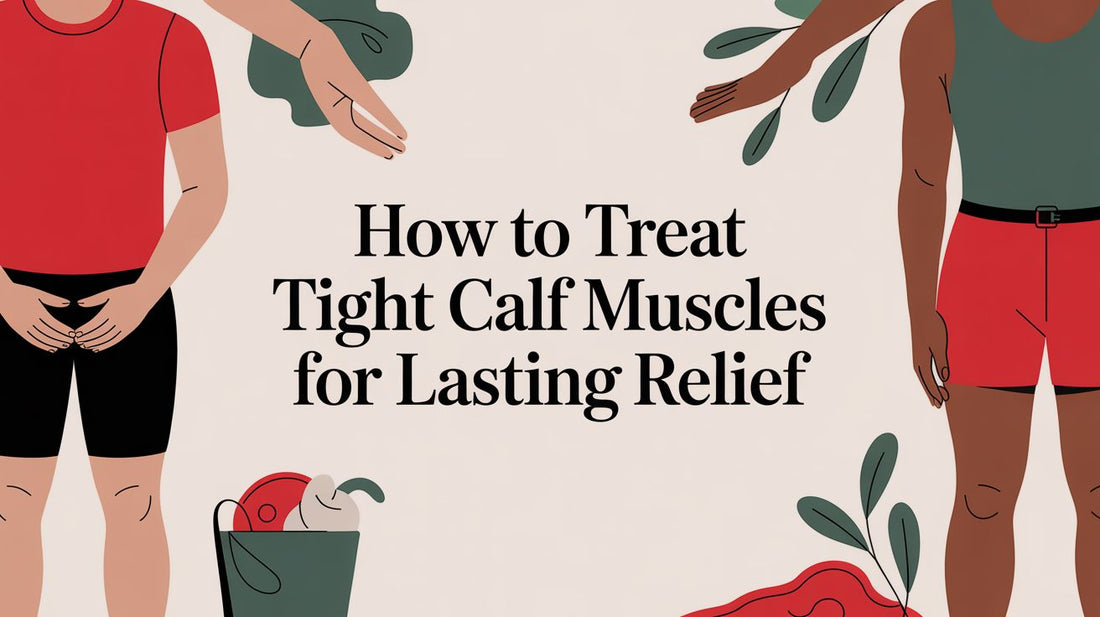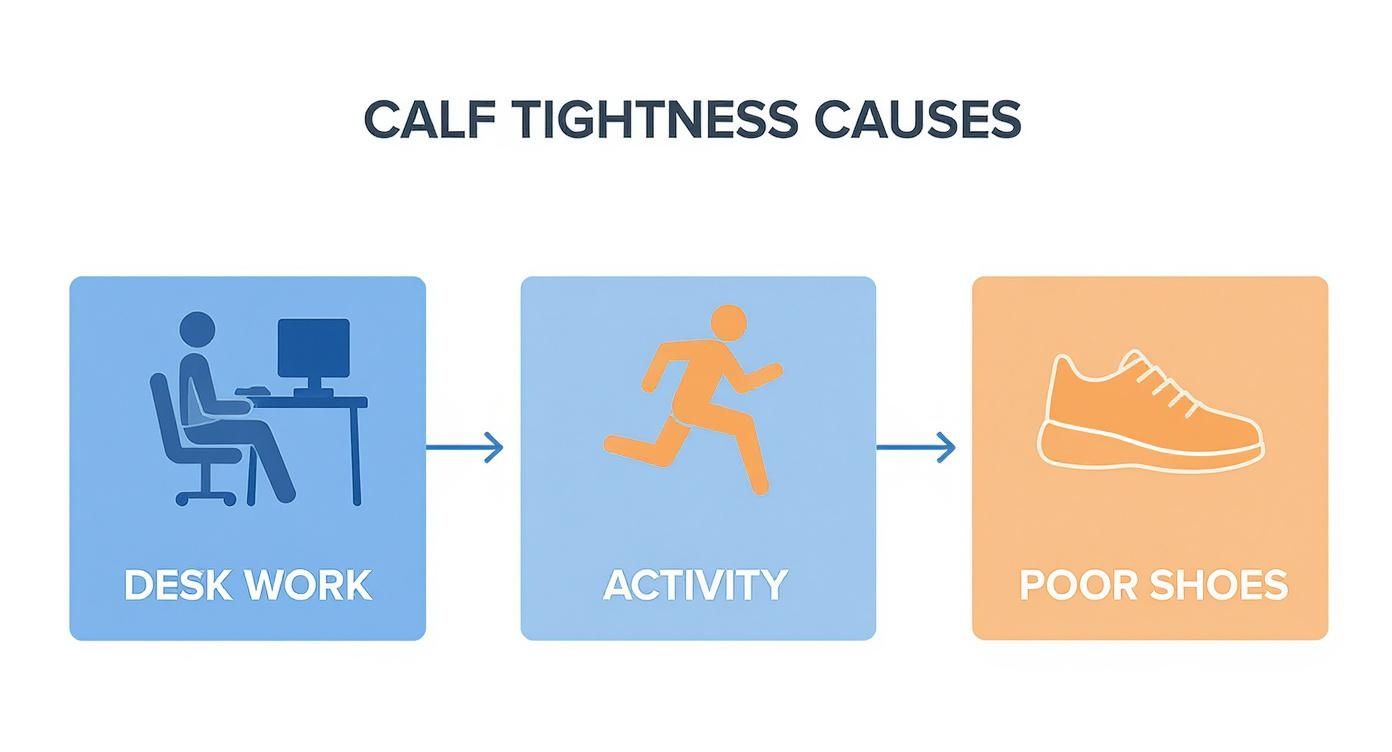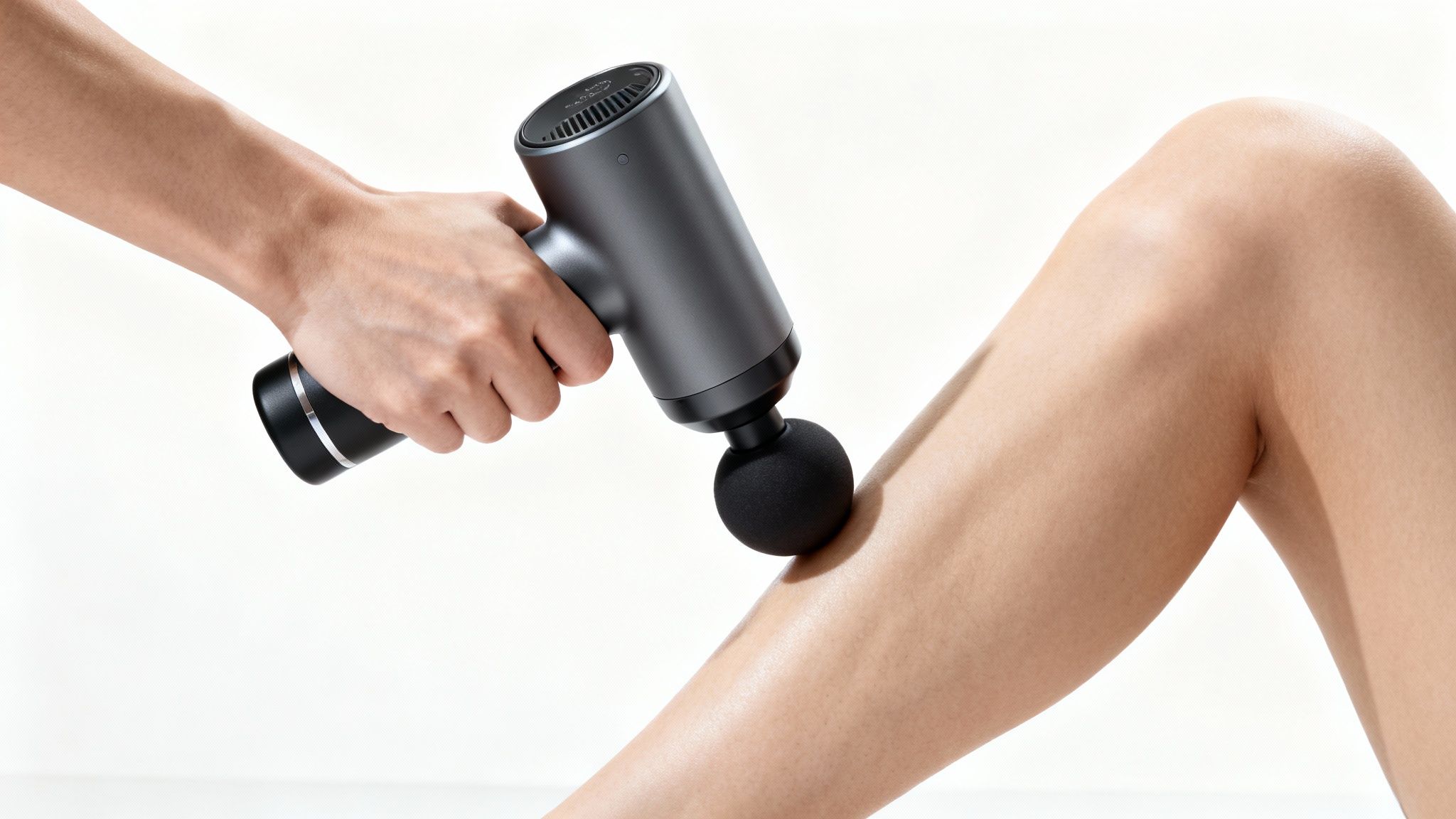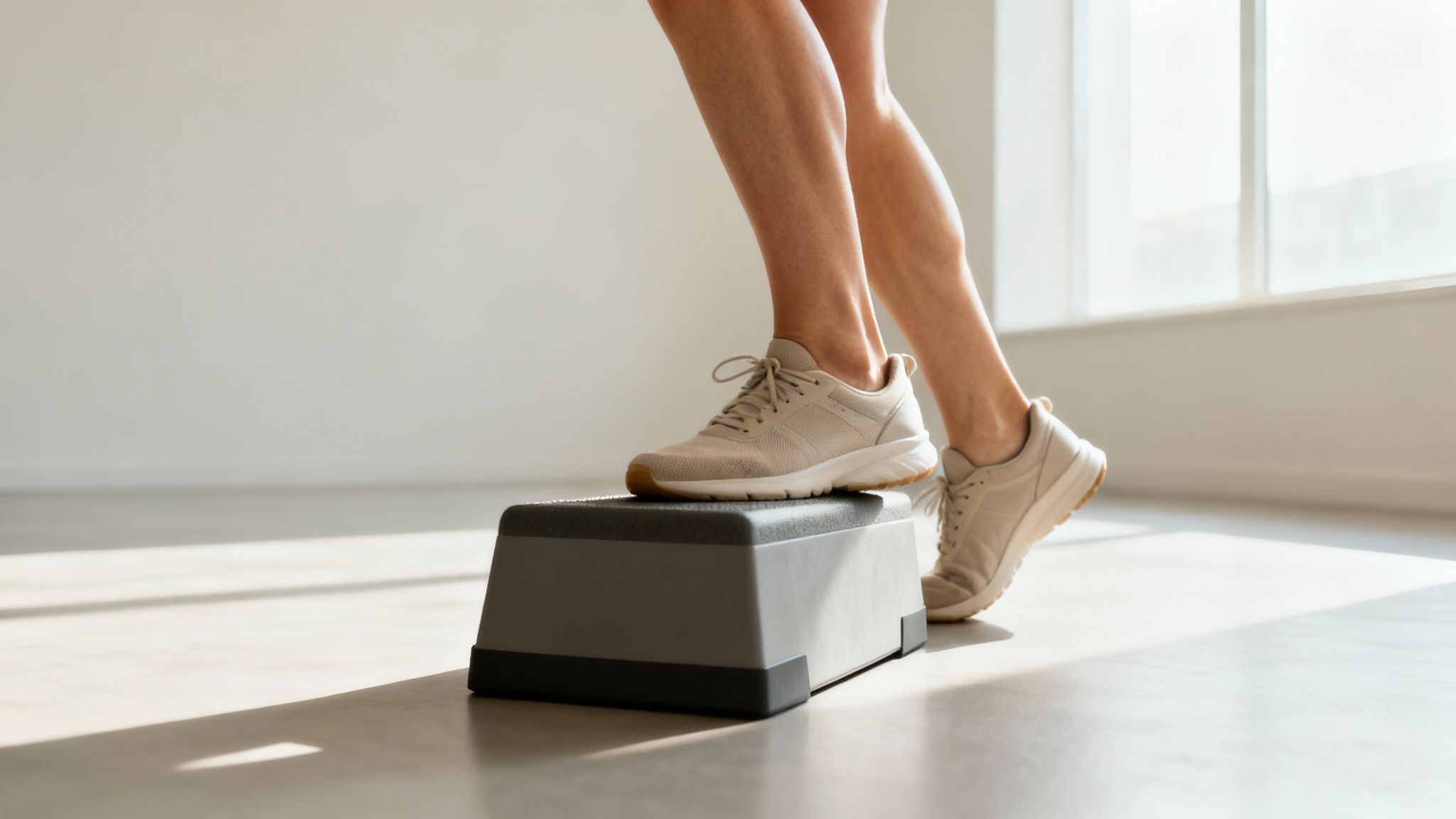
That nagging tightness in your lower legs? It’s more than just a minor annoyance—it’s your body’s signal that something needs attention. Understanding how to treat tight calf muscles begins with figuring out why they feel so tense in the first place. This isn't just a problem for marathon runners; office professionals, athletes, and travelers all know this feeling well.
Our goal is to give you practical, actionable steps to find relief and keep your lower legs feeling great.
Why Your Calves Are Always So Tight
Think of your calves as the hard-working foundation of your lower body. They consist of two main muscles: the large, powerful gastrocnemius on the outside and the deeper soleus muscle underneath. Together, they help you walk, run, jump, and even just stand still.
When these muscles feel like a knotted rope, it's usually a symptom of overuse, underuse, or daily habits catching up with you. That constant tension can come from a few different places. A tough workout creates tiny tears in the muscle fibers, which leads to soreness as they heal. On the other hand, sitting all day can cause those same muscles to shorten and lose flexibility, creating a similar tight, locked-up feeling.
Common Causes of Calf Soreness
So, what are the usual suspects behind that familiar ache in your lower legs? Pinpointing your personal triggers is key to finding relief that actually lasts.
- Sitting or Standing All Day: When you stay in one position for hours, blood flow can be restricted, and your muscles start to stiffen. This is why many office workers feel it by the afternoon, even without a trip to the gym.
- Dehydration: This is a big one and often overlooked. Your muscles need water to function properly. Even mild dehydration can make you more prone to cramps and tightness.
- The Wrong Shoes: Wearing shoes without good arch support forces your calf muscles to work overtime to keep you stable. That constant strain can lead directly to fatigue and soreness.
- Skipping Your Warm-Up: Pushing yourself in a run or a gym session without a proper warm-up and cool-down is a surefire way to end up with sore calves the next day.
Getting to the bottom of these root causes is what it’s all about. It shifts you from just reacting to discomfort to proactively preventing it. Once you know the "why," you can build a smarter routine to keep your calves happy.
Effective Stretches for Calf Muscle Relief
When your calves feel tight, your first instinct is probably to stretch them. That’s a good instinct! But to get real relief, you need targeted stretches that address both of the major calf muscles—the large gastrocnemius and the deeper, often-ignored soleus.
Knowing how to treat tight calf muscles with stretching is less about how far you can bend and more about using proper, consistent form.
The Classic Standing Wall Stretch
This is a go-to calf stretch for a reason: it’s fantastic for the upper part of your calf (the gastrocnemius). However, improper form can limit its effectiveness.
Here’s how to do it right:
- Stand facing a wall, about an arm's length away, with your hands on the wall for balance.
- Step one foot straight back, keeping that leg completely straight and your heel flat on the floor.
- Slowly lean forward by bending your front knee until you feel a gentle, solid stretch in the calf of your back leg.
- Hold for 30 seconds. Avoid bouncing, as that can cause the muscle to tense up.
- Switch legs and repeat two to three times per side.
The key here is to ensure your back foot points straight ahead, not angled outward. That small adjustment helps isolate the stretch where it counts.
Targeting the Deeper Soleus Muscle
The classic wall stretch feels great, but it often misses the soleus muscle, which sits underneath the gastrocnemius. If you have a deep, nagging ache in your lower leg, this muscle is often the culprit.
This infographic breaks down some common reasons your calves might feel tight, from desk jobs to footwear choices.

As you can see, our daily habits are a huge factor, which is why a consistent stretching routine is so important. To reach the deeper soleus muscle, you just need a slight tweak to the stretch you already know.
Pro Tip: The soleus muscle requires a bent knee to get a proper stretch. The sensation will be less intense than the classic wall stretch, but you're targeting a different area of your lower leg.
Get back into the same wall-facing position. This time, as you lean in, let the knee of your back leg bend slightly while keeping your heel flat on the floor. You'll feel this stretch much lower down, closer to your Achilles tendon. Hold for 30 seconds, then switch sides. This tiny change can be a game-changer for complete calf relief.
If your tightness is more severe, you might be dealing with a strain that needs a more structured approach. Physical therapy protocols can be a standard for addressing calf injuries, with recovery often taking three to six weeks. These programs are designed to protect the tissue while gradually reintroducing load to promote healing. You can explore the full calf strain recovery protocol here to see what that looks like.
Adding both of these stretches to your daily routine is a huge step toward unlocking tight calves. For more recovery tips, check out our guide on what a massage gun does to support muscle health.
Using a Massage Gun for Percussive Therapy
While stretching is a fantastic daily habit, sometimes your calves have knots that just won't seem to budge. This is where a little technology can make a world of difference.
Using a tool like the Cryotex Massage Gun for percussive therapy allows you to go deeper, helping to break up stubborn tightness. It's a powerful and practical way to address tight calf muscles right in your own home. The rapid pulses help support circulation, sending fresh oxygen into your muscle tissues and helping to flush out metabolic byproducts that contribute to soreness. Think of it as a targeted massage that helps your muscles relax after a tough workout or a long day.

Picking the Right Attachment and Speed
Your Cryotex massage gun comes with different attachment heads, and for your calves, two are excellent options:
- The Round Ball Head: This is your everyday workhorse. Its wide surface is perfect for warming up the larger part of your calf (the gastrocnemius) or for a general, soothing massage to ease overall tightness.
- The Bullet Head: Think of this one for precision. When you find a specific trigger point or a stubborn knot, the bullet head delivers focused pressure right where you need it most.
A good rule of thumb: always start on the lowest speed setting. Let your muscles get used to the sensation before increasing the intensity. More power isn't always better—the goal is relief, not discomfort.
Your 90-Second Calf Relief Routine
Ready to feel the difference? Here’s a simple and effective 90-second routine you can do for each calf. Just remember to keep the massage gun on the soft, fleshy parts of your leg.
Safety First: Never use a massage gun directly on bones (like your shin), joints, or the sensitive Achilles tendon behind your ankle. Stick to the muscle belly for safe and effective results.
Here’s the simple flow to follow:
- Warm-Up (30 seconds): Using the round ball head on the lowest speed, gently glide the massage gun up and down the length of your calf. Move from just above your ankle toward the back of your knee.
- Address Knots (45 seconds): Stick with the round head or switch to the bullet head. Slowly scan your calf for any spots that feel extra tight. When you find one, hover over it for 15-20 seconds with gentle pressure.
- Final Flush (15 seconds): Switch back to the round head and the lowest speed. Do one last, light sweep over the entire muscle to soothe it and promote circulation.
This quick routine can be a total game-changer when done consistently. It helps improve flexibility, reduce next-day soreness, and provides a great feeling of release. To learn more about the science behind it, check out our guide on what a massage gun does.
Your Quick Guide to Calf Massage Gun Settings
Use this table as a cheat sheet to tailor your Cryotex session for what your calves need.
| Goal | Recommended Speed Setting | Attachment Head | Duration Per Calf |
|---|---|---|---|
| Pre-Workout Warm-Up | Low (1-2) | Round Ball | 30-45 seconds |
| Post-Workout Recovery | Medium (2-3) | Round Ball | 60-90 seconds |
| Targeting Knots | Low to Medium (1-3) | Bullet Head | 15-20 seconds per spot |
| General Relaxation | Low (1) | Round Ball | 60 seconds |
Remember, these are just guidelines. The most important thing is to listen to your body and find what feels best for you.
How to Build Stronger, More Resilient Calves
Stretching and massage feel great, but lasting relief from tight calves often comes from building strength. Think of it as the difference between constantly putting out fires and making your muscles more resilient in the first place.
A strong, balanced foundation in your lower legs supports everything you do. From pushing off the ground during a run to just walking up a flight of stairs, strong calves act like powerful shock absorbers, taking strain off your feet, ankles, and knees.

Simple Yet Powerful Calf Exercises
You don't need a fancy gym membership to build powerhouse calves. These two exercises are incredibly effective because they target both major muscles in your lower leg.
- Straight-Knee Calf Raises: This classic move targets the large gastrocnemius muscle. Stand flat-footed, then slowly press up onto the balls of your feet, lifting your heels high. Pause at the top, then slowly lower back down.
- Bent-Knee Calf Raises: To reach the deeper soleus muscle, perform the same movement but keep your knees slightly bent. Your range of motion will feel smaller, but this is a fantastic way to build lower-leg stability.
Want to level up? Try doing these on a stair for a deeper stretch on the way down. You can also add a set of Cryotex Resistance Bands to increase the intensity and build strength even faster. Aim for 3 sets of 15-20 repetitions for each exercise a few times per week.
The Bigger Picture: Your Calves and Overall Health
This isn't just about avoiding soreness. The health of your calf muscles is linked to your overall well-being in surprising ways.
Strong calves aren't just for athletes—they're a key indicator of functional health, playing a vital role in mobility and circulation as we age.
Research backs this up. One study found a connection between lower calf muscle density and overall health outcomes. It’s a serious reminder of how crucial lower leg strength is for maintaining your quality of life. You can read the full research about preserving muscle strength here if you want to dive deeper.
By spending just a few minutes a week on these exercises, you’re not just learning how to treat tight calf muscles—you’re investing in a more mobile and active future.
Everyday Habits for Healthy Happy Calves
Figuring out how to treat tight calf muscles isn’t just about stretching after you feel sore. Real, lasting relief comes from the small, smart choices you make all day. These simple habits help keep your muscles healthy and stop tightness before it starts.
It might sound too simple, but hydration is a massive piece of the puzzle. Your muscles are about 79% water, so even minor dehydration can make them feel stiff and prone to cramping. When you're hydrated, your muscles are more elastic. Think of it like a dry, brittle sponge versus a wet one. The wet sponge is flexible, and that's how you want your muscles to be.
The Foundation Under Your Feet
Your shoes have a direct line to your calves. Footwear that lacks proper arch support forces your calf muscles to work overtime just to stabilize your feet with every step. That extra strain adds up, leaving you with that familiar nagging tightness.
Here are a few things to keep in mind for smarter footwear:
- At the Office: If you wear dress shoes or flats, consider supportive insoles. Try to avoid spending all day in high heels, as they hold your calves in a constantly shortened position.
- For Workouts: Match your athletic shoes to your activity. Running shoes and cross-trainers are built differently for a reason.
- Around the House: Even walking barefoot on hard floors can be stressful for your calves. A comfortable pair of supportive slippers can make a difference.
This is about being mindful of how your footwear either supports your body's natural mechanics or works against them.
Movement and Nutrition
If you're stuck at a desk all day, your calves remain in a shortened, inactive state for hours. The simple act of getting up to walk around for two minutes every hour can dramatically improve blood flow and help prevent stiffness. Set a timer—it’s a tiny interruption with a huge payoff.
"I used to get terrible calf cramps by the end of my workday. Just getting up to walk to the water cooler every hour changed everything. It's so simple, but it works." - Jessica L., Chicago, IL
Finally, what you eat matters. Key minerals like magnesium and potassium are important for proper muscle function. Including foods like bananas, avocados, spinach, and nuts in your regular diet supports your muscles from the inside out.
For athletes dealing with more than just simple tightness, a more structured approach may be necessary. You can discover more about personalized injury mitigation strategies here, as managing calf strains often requires a systematic process tailored to the individual.
Common Questions About Calf Muscle Care
Even with a solid routine, questions pop up. Getting the right answers helps you stay on track and feel confident you’re doing what’s best for your body. Let's dig into some of the things people ask most often.
How Often Should I Be Stretching My Calves?
The short answer? Daily.
Consistency is far more important than one intense stretching session per week. If you're active, a few dynamic stretches before you start and holding a static stretch for 30 seconds afterward is a great habit. On your off days, a quick stretch in the morning or evening helps maintain flexibility.
Is It Possible to Overuse a Massage Gun on My Calves?
Yes, it is. A massage gun is a fantastic tool, but you can have too much of a good thing.
You only need about 60 to 90 seconds per calf. That’s plenty of time to support circulation and work out soreness. Going longer or pushing too hard can backfire, causing more inflammation and tenderness. For a deeper dive, check out our guide on how often you should use a massage gun. The biggest takeaway is to listen to your body—if it feels too intense, it probably is.
"I used to think blasting my calves for five minutes straight was the answer. It just made them angrier. Once I switched to short, 90-second sessions daily, I felt a huge difference in my recovery." - David R., New York, NY
Should I Use Heat or Ice for My Tight Calves?
This is a classic question, and it really depends on what’s going on.
For general, nagging muscle tightness without any swelling, heat is often your best friend. It helps relax the muscle fibers and gets the blood flowing. Try a warm compress or a heating pad for 15-20 minutes. Ice, on the other hand, is generally used for fresh, acute injuries where you see swelling to help reduce that inflammation.
How Do I Know if It Is Just Tightness or an Injury?
Knowing the difference is critical. General tightness usually feels like a dull, nagging ache that improves with gentle movement or stretching.
An injury, like a muscle strain, often involves a sharp, sudden pain, especially during an activity. Here are a few red flags that may point to something more serious:
- Obvious swelling or bruising
- Weakness in your calf or trouble pointing your toes
- Pain that gets worse, not better, when you move
If the pain is sharp, came on suddenly, or isn't getting better after a day or two of gentle care, it’s time to see a healthcare professional. Don't guess when it comes to injuries.
At BestMassageGun.com, we believe that feeling your best starts with smart, consistent self-care.